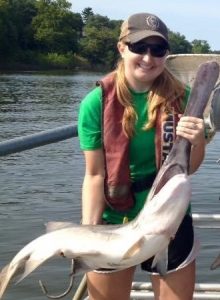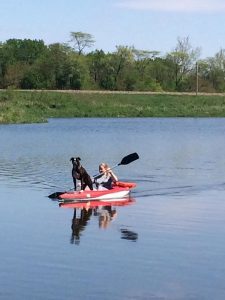By Lindsay Keeney
Downstate Outreach Director, Illinois Environmental Council
You can’t protect something you don’t love. Nurtured in central Illinois creek beds that had a tendency to banish a nice pair pair of school clothes straight to the dirty clothes pile, I love water. Geography gifted me the chance play, fish and study water from an early age and my addiction to the outdoors and to water has yet to subside. Now, I work to protect it every day.
I grew up in Ashland, Illinois with Jim Edgar Panther Creek State Fish and Wildlife Area practically in my backyard. I spent countless hours during adolescence exploring and wading in creeks, canoeing, and navigating the surprisingly complicated politics of farm pond fishing access.
Fittingly, one of my very first jobs was working at the Jim Edgar Panther Creek Area. This was the first time I was immersed into the community of sportsmen. I got to run the dove drawing at 6am, help with wingshooting clinics, and greet the out of state hunters, who were always elated to get a chance to hunt in Illinois. While I loved central Illinois, I had never realized that it was such an outdoors destination.
It would start getting busy on Thursdays, as families seeking a getaway and some prescription nature arrived for their long weekend. Early Sunday mornings you would hear “Well, I think the lord would rather me be in a boat thinking about him, than in church thinking about the fish.” I met people from all over the world in that office, and got to hear hundreds of stories about why they loved the outdoors, and many were surprisingly similar. Most, like me, fell in love with nature during childhood. They told tales of moms, dads, and grandparents taking them exploring, hunting, and fishing. They sought the outdoors in times of stress and uncertainty. They had strong opinions about conservation and were well informed about habitat management. These outdoorsmen wanted to be sure their children and grandchildren would be afforded the same opportunities to experience the outdoors that they enjoyed.
People with passion drive change, and there is no passion more embedded in tradition and heart than that of the sportsman. Passed down through generations, if a love of the outdoors is not inherent from birth it is ingrained through every cast, reel, hike and hunt.
After graduate school, I had the opportunity to work as a fisheries technician at Illinois River Biological Station in Havana, Illinois where I collected data on water quality, fish populations, zooplankton, and aquatic vegetation in The Nature Conservancy’s Emiquon National Wildlife Refuge and in the Illinois River. During my time in Havana, I worked to soak up (pun intended) as must as I could from the talented (and passionate) biologists working there. I couldn’t believe it was possible to make a career studying and advocating for wildlife wild places, or as my husband would tease, “getting to fish all day.” But I assure you that it wasn’t all fun and games.
While at IRBS, I witnessed firsthand many of the environmental issues faced by large river systems. Toxic algal blooms, agricultural nutrient runoff, invasive silver carp, and problems caused by floodplain development and urban pollution all made an appearance on the a small stretch of the Mississippi river system I worked on. I was also fortunate to learn about and experience the resiliency of river systems.
The story of Emiquon is a testament to the tenacity of rivers and wetlands to recover and restore natural habitat. During the flood of 2014, I watched the river swell and spread to create wetlands and inflate backwater lakes. The landscape changed so quickly; the landmarks I used to navigate were gone or drastically shifted. I was thankful for the experienced biologists leading our work, because I would have been quickly turned around. As the field season pressed on the water fell as quickly as it rose, demonstrating the power of the natural flood cycle, which left rejuvenated habitat but significant complications for people as it receded. My little stretch of river served as a microcosm for the larger Mississippi River system and watershed. As waterways and rivers join together and flow south toward the Gulf of Mexico, I could see how people were affecting it at every stage.
These experiences and observations reframed how I thought about the areas surrounding our large rivers, the conventional agriculture landscape I grew up in, and ultimately changed how I thought about our food system as a whole. Iam fortunate to be able to continue learning and working on these issues with Illinois Stewardship Alliance and Illinois Environmental Council. With these organizations, I have been involved in policies and projects that are making our food and agriculture system more sustainable, just, and fruitful for family farmers. I am immensely proud of the accomplishments of these organizations and of my involvement with them, but there is still a tremendous amount of work to do.
I believe that the value of wild spaces in Illinois is immeasurable. To protect these places, we must draw on the passion of those with a special connection to them, like the sportsmen and enthusiasts, scientists, farmers and landowners, and advocates. I’m lucky to consider myself all of these things.
On a recent trip to the Shawnee National Forest, a park ranger chastised me, “You’ve never been here before? If you pay taxes this place belongs to you, you better see as much as you can and get your money’s worth!” The most crucial thing we can do to make an impact in protecting our natural areas is to share our passion, whether it be taking a grandchild fishing, volunteering to teach a wingshooting clinic at a local state park, or lending your expertise to a fellow angler or hunter in the field. You can’t protect something you don’t love. So to protect the places we love, it’s our responsibility to help others fall in love with the Illinois outdoors.
About the Author:
Lindsay studied biology in undergrad at MacMurray College in Jacksonville, IL and in graduate school at the University of Illinois at Springfield. Lindsay’s areas of interest include aquatic ecology, pollinators and invertebrate diversity, sustainable agriculture, and Illinois open space and water conservation. This diverse interest list was inspired by the various environmental positions she has held throughout her career including positions with; Illinois Department of Natural Resources’ Jim Edgar State Fish and Wildlife Area, The Illinois Environmental Protection Agency, Illinois Natural History Survey’s Illinois River Biological Station and the Illinois Stewardship Alliance.
Reach Lindsay at lkeeney at ilenviro dot org
